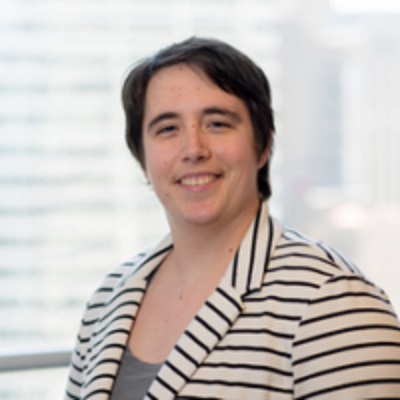
“Peaced Together”

Dr. Abigail Schlesinger
Pittsburgh, PA
Survivor
Twist on Cancer: In May 2005 I was alone in my car, crying waiting for a Susan G Komen walk to pass while I waited to learn the prognosis for the “cancer throughout my blood and on my liver.” Luckily, the cancer (Hodgkin’s Lymphoma) had a great prognosis. Six months of chemotherapy barely slowed me down(despite a massive pulmonary embolism). People came out of the woodwork, they sent cards, wrote long handwritten letters, and sent hats from all over the US. The support was amazing.
Five years later I was thrilled to be cured and discharged from oncology. The ensuing years flew by with more highs than lows. The pink ribbons in October became my nemesis. I was not one of those women and I hated being asked what I learned from cancer. Why did I have to learn anything? Couldn’t I just move on?
Depression threw a shroud over my life in 2001. Because I didn’t tell many people I had depression,people didn’t know I needed help. Treatment – including therapy and medication – did help. But it was hard to access, and each barrier made me feel worse. Depression was lonely, and ate me up from the inside out. I was lucky that it didn’t last long, but the period of time is unforgettable
While depressed, I ruminate over my inability to consistently see a primary care doctor. I couldn’t ignore my risks any longer. A friend forced me to see a PCP and a therapist. I took my antidepressant, went to therapy and started catching up on my own wellness. I got a beautiful new car and my first mammogram the year I turned 50. The excitement was overflowing when I told the tech that I was 18 years cancer free. The tech remembered me the next year, even before she saw the ominous sign in my imaging.
By my 51st birthday I had a partial lumpectomy and had just started 12 rounds of weekly chemotherapy. I wanted people to know, and the people that knew all helped in their own ways. Again I got cards, gifts and now food – for my family. I was proud to continue to work through treatment, and delighted that my prognosis was so good. My targeted treatment plan means I am very likely to be alive in 10 years rather than dead in 3-5. Saved by modern medicine again.
Depression, like breast cancer, could come back with a vengeance. Luckily the basic behaviors that help keep cancer and depression at bay are similar -– stay on top of my health needs, stay connected to friends and family, eat well, sleep well and exercise. There are no guarantees, and none of these basics are simple to master. But every year I master something new and I’m hoping to have many more years to come.

Cai Fasse
Chicago, IL
“Peaced Together”
Mixed media collage
24” x 20” x .75”
$250
Artist Statement: What struck me most in my discussions with Abby was how prominent depression was in her experience with cancer. I wanted to capture the many layers of coping with two different instances of cancer as well as depression. I used mixed media with layers of collaging different kinds of paper to represent the ubiquity of cancer cells in her life and black paint tendrils and pits to represent the depression. Some of the elements are abstract, and some of them are more literal, including snippets from the DSM-5 diagnostic information on depression; the only clear element from the DSM-5 is the diagnostic codes, which appear “early” in the painting, with later snippets obscured by layers of green and purple paint, colors chosen specifically for their connections to how cancer cells are dyed and lime green to represent one of her cancer diagnoses. In the top left quadrant are abstract elements of Reed-Sternberg cells to represent Hodgkin’s Lymphoma, Abby’s first experience with cancer. The chaotic array of puzzle pieces represents the struggle of trying to gain a more cohesive meaning from the experience. It was important as I was placing the puzzle pieces for the viewer to struggle with knowing which direction some of them should go, and at the same time, it was important for it to be a realistic representation of what it’s like to try and put a puzzle together. Usually, we start with the corners and build around them. In the lower right-hand corner are the only pieces that have started to fall into place, literally stitched together by breast cancer ribbons – representative of the support Abby received from Susan B Komen and the breast cancer community. Since cancer came into her and her family’s lives, she started doing puzzles with her son and her father when he visited. She remarked on how puzzles are not unlike life; when the pieces come together, they form a coherent picture. While the entire piece is not in the form of a coherent picture, I knew that in order to create something reflective of the story she has shared with me, ultimately, the piece must end with a feeling of connection.